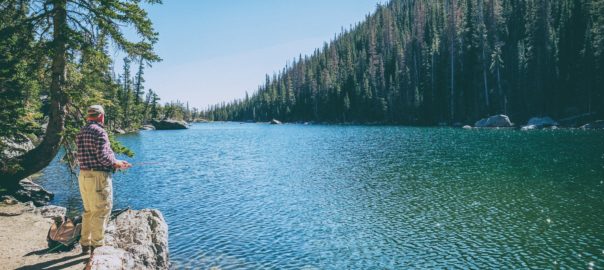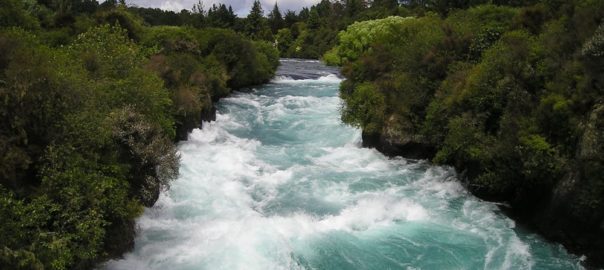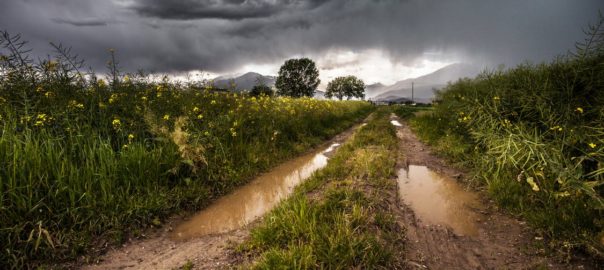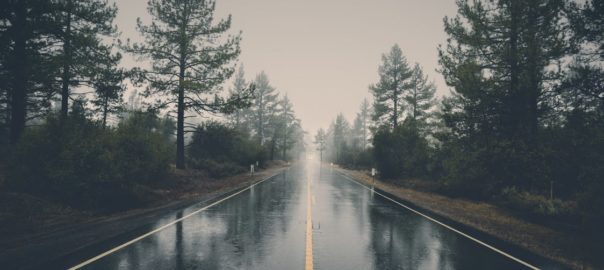Floods are a real danger in our world, and one that most people don’t give a second thought to until they are literally knee deep in flood waters. Some floods are foreseen, such as an upcoming hurricane. But others, like the 2013 floods in Colorado, seemingly sprang out of nowhere after several days of extremely heavy rain created torrents in once quiet mountain streams. Floods can be devastating for their destruction to property and people’s lives, but there are a few things you can do to increase your flood preparedness.
Flood Preparedness 101
What is a flood?
Flooding is an overflowing of water onto land that is normally dry. Flooding may
happen with only a few inches of water, or it may cover a house to the rooftop.
When do floods happen?
Flooding can occur during any season, but some areas of the country are at greater
risk at certain times of the year. Coastal areas are at greater risk for flooding during
hurricane season (i.e., June to November), while the Midwest is more at risk in the
spring and during heavy summer rains. Ice jams occur in the spring in the Northeast
and Northwest. Even the deserts of the Southwest are at risk during the late
summer monsoon season.
Where do floods occur?
Flooding can happen in any U.S. state or territory. It is particularly important to be
prepared for flooding if you live in a low-lying area near a body of water, such as a
river, stream, or culvert; along a coast; or downstream from a dam or levee.
How does flooding happen?
- Flooding can occur in several ways, including the following.
– Rivers and lakes cannot contain excessive rain or snowmelt.
– Excessive rain or snowmelt cannot be fully absorbed into the ground.
– Waterways are blocked with debris or ice and overflow.
– Water containment systems break, such as levees, dams, or water or sewer
systems.
– Strong winds from tropical storms or hurricanes cause a storm surge by pushing
seawater onto land.
The speed and duration of flooding can vary significantly.
– Flooding can occur slowly as rain continues to fall for many days. This type of
flooding, sometimes called a slow-onset flood, can take a week to develop and can
last for months before floodwaters recede.
– Rapid-onset floods occur more quickly, typically developing within hours or days.
These types of floods usually occur in smaller watersheds experiencing heavy
rainfall, particularly in mountainous and urban areas, and the water usually recedes
within a few days.
– Some rapid-onset floods known as flash floods occur very quickly with little or no
warning, such as during periods of extremely heavy rain or when levees, dams,
ice jams, or water systems break. Densely populated areas are at a high risk for
flash floods. In urban areas, flash floods can fill underpasses, viaducts, parking
structures, low roads, and basements.
– The strong winds of a tropical cyclone or hurricane can push large amounts of
seawater up onto the land, causing a storm surge. A storm surge combines
with the ocean’s tide to produce a storm-tide surge. Storm-tide surges have
been registered as high as almost 35 feet above normal sea level and can cause
significant flooding across a large area. This generally occurs over a short period,
typically 4 to 8 hours, but in some areas, it can take much longer for the water to
recede to its pre-storm level.
The Impact of a flood
The physical destruction caused by flooding depends on the speed and level
of the water, the duration of the flood, terrain and soil conditions, and the built
environment (e.g., buildings, roads, and bridges).
– Flooding can cause fatalities and serious injuries for people who are trapped or
swept away by wading in, driving through, or boating across floodwaters.
– Transportation routes, power, water, gas, and other services may be disrupted.
– Commercial supplies and government support systems may be temporarily
unavailable.
– Drinking water supplies and wells may become polluted.
– Floodwaters can cause erosion, which can damage roads, bridge structures, levees,
and buildings with weak foundations, causing their collapse without warning. The
floodwaters may carry the worn-away mud, rocks, and other sediment.
– Landslides and mudslides can occur.
– Even a few inches of floodwater in a home can cause tens of thousands of dollars
in damage.
Flood-related injuries and deaths are often the result of individuals trapped in floodwaters. The best way to stay safe is to leave areas that flood and avoid floodwaters.
Steps to take for Flood Preparedness
Know your flood risk. Learn whether you live, work, or travel through areas
that are prone to flooding. To help communities understand their risk of flooding,
the Federal Emergency Management Agency (FEMA) creates flood maps (Flood
Insurance Rate Maps, or FIRMs) to show the locations of high-risk, moderate-tolow
risk, and undetermined risk areas.
Practice an Emergency Plan
Practice how you will communicate with family members. In a dangerous
situation, your first thoughts will be the safety of your family and friends. In case you
are not together when authorities issue a flood watch or flood warning, practice how
you will communicate with each other. Remember that sending texts is often faster
than making a phone call. Keep important numbers written down in your wallet not
just in your phone. It is sometimes easier to reach people outside of your local area
during an emergency, so choose an out-of-town contact for all family members to call
or use social media. Decide where the members of your household will meet after the
flood. Visit www.ready.gov/make-a-plan for instructions on developing a Household
Communication Plan.
Store Life Saving Supplies
Store supplies so you can grab them quickly if you need to evacuate; know
in advance what else you will need to take. Take time now to make a list of the
things you would need or want to take with you if you had to leave your home quickly.
Store the basic emergency supplies in a “Go Bag” or other container. Be ready to
grab other essential items quickly before leaving. Remember to include specialized
items for people with disabilities and others with access and functional needs such
as older adults, children, and those with Limited English Proficiency
Flood Preparedness During a Flooding Event
EVACUATE
– If authorities advise or order you to evacuate, do so immediately. Be sure to
remember the Five Ps of Evacuation: People, Prescriptions, Paper, Personal
Needs, and Priceless Items.
– If you are in the path of a slow-onset flood and there is time before you need to
evacuate, consider the following strategies.
✓Move items you want to protect to a higher floor.
✓Turn off gas, water, and electricity if you know how and can do it safely.
Do not touch electrical equipment if it is wet or you are standing in water.
✓Put sandbags around your property.
If Floodwater is present:
If you see floodwater on roads, walkways, bridges, and on the ground, do not
attempt to cross. The depth of the water is not always obvious and the roadbed
may be washed out under the water. Moving water has tremendous power. Six
inches of moving water has the potential to knock you off your feet, and a foot of
water can sweep a vehicle—even a large SUV—off of the road. Floodwaters can
contain rocks, mud, other debris, oil, gasoline, and even sewage. Be especially
cautious at night when it is harder to recognize flood dangers. For more information
on floodwater hazards, visit the NWS Turn Around Don’t Drown® program at
http://tadd.weather.gov.
If You are Trapped
If you do not leave before the flooding reaches your immediate area and you
are trapped, call 911 if possible. Give your location and explain your situation.
IN A BUILDING
– Go to the highest level of the building. Avoid basements and lower floors, but do
not climb into a closed attic as you may become trapped by rising floodwater.
– Go onto your roof only if necessary. Signal for help.
IN A VEHICLE
– If floodwater is blocking your evacuation route but you can turn around safely, turn
around and go to a building on high ground.
– If your vehicle is trapped in rapidly moving water, stay in the vehicle. If water is
rising inside the vehicle, seek refuge on the roof.
OUTDOORS
– Move to higher ground and, if necessary, climb as high as possible on a sturdy object.
For a more complete Flood Preparedness Guide, please find the FEMA How to prepare for a flood pamphlet here.
DO YOU NEED FLOOD INSURANCE?
Fill out a quote form today and find out how Save Flood Insurance Agency Inc can get you covered for potential flooding disasters.
RESOURCES
If you would like more information, the following resources
may be helpful.
– American Red Cross, Repairing Your Flooded Home:
www.redcross.org/images/MEDIA_CustomProductCatalog/m4340135_file_
cont333_lang0_150.pdf
– FEMA Above the Flood: Elevating Your Floodprone House:
www.fema.gov/media-library/assets/documents/725
– FEMA After a Flood: The First Steps:
www.fema.gov/media-library/assets/documents/3396
– FEMA Homeowner’s Guide to Retrofitting: Six Ways to Protect Your House From
Flooding: www.fema.gov/media-library/assets/documents/480
– FEMA Hurricane Sandy Issue Paper: Guidance for Turning the Power Back On:
www.fema.gov/media-library/assets/documents/29788
– FEMA Hurricane Sandy Recovery Fact Sheet #1: Cleaning Flooded Buildings:
www.fema.gov/media-library/assets/documents/31368?id=7128
– FEMA Protecting Building Utilities From Flood Damage:
www.fema.gov/media-library/assets/documents/3729
– FloodSmart: www.floodsmart.gov/floodsmart
– NWS Flood Safety Awareness: www.floodsafety.noaa.gov
– NWS Hurricane Flooding: A Deadly Inland Danger:
www.nws.noaa.gov/om/brochures/InlandFlooding.pdf
– NWS NOAA River Forecast:
www.water.weather.gov/ahps2/index.php?wfo=bmx
– NWS The Hidden Danger: Low Water Crossing:
www.nws.noaa.gov/om/brochures/TheHiddenDangerEnglish.pdf
– NWS Tropical Cyclone Inland Flooding:
www.nws.noaa.gov/om/brochures/TropicalCycloneInlandFlooding.pdf
– NWS Turn Around Don’t Drown®:
www.nws.noaa.gov/os/water/tadd/tadd-resources.shtml#brochures
– Ready: www.Ready.gov/floods
– Substance Abuse and Mental Health Services Administration (SAMHSA), DisasterSpecific
Resources: Annotated Bibliography:
www.samhsa.gov/dtac/dbhis/dbhis_specific_bib.asp#disaster
– USGS WaterAlert: http://maps.waterdata.usgs.gov/mapper/wateralert





